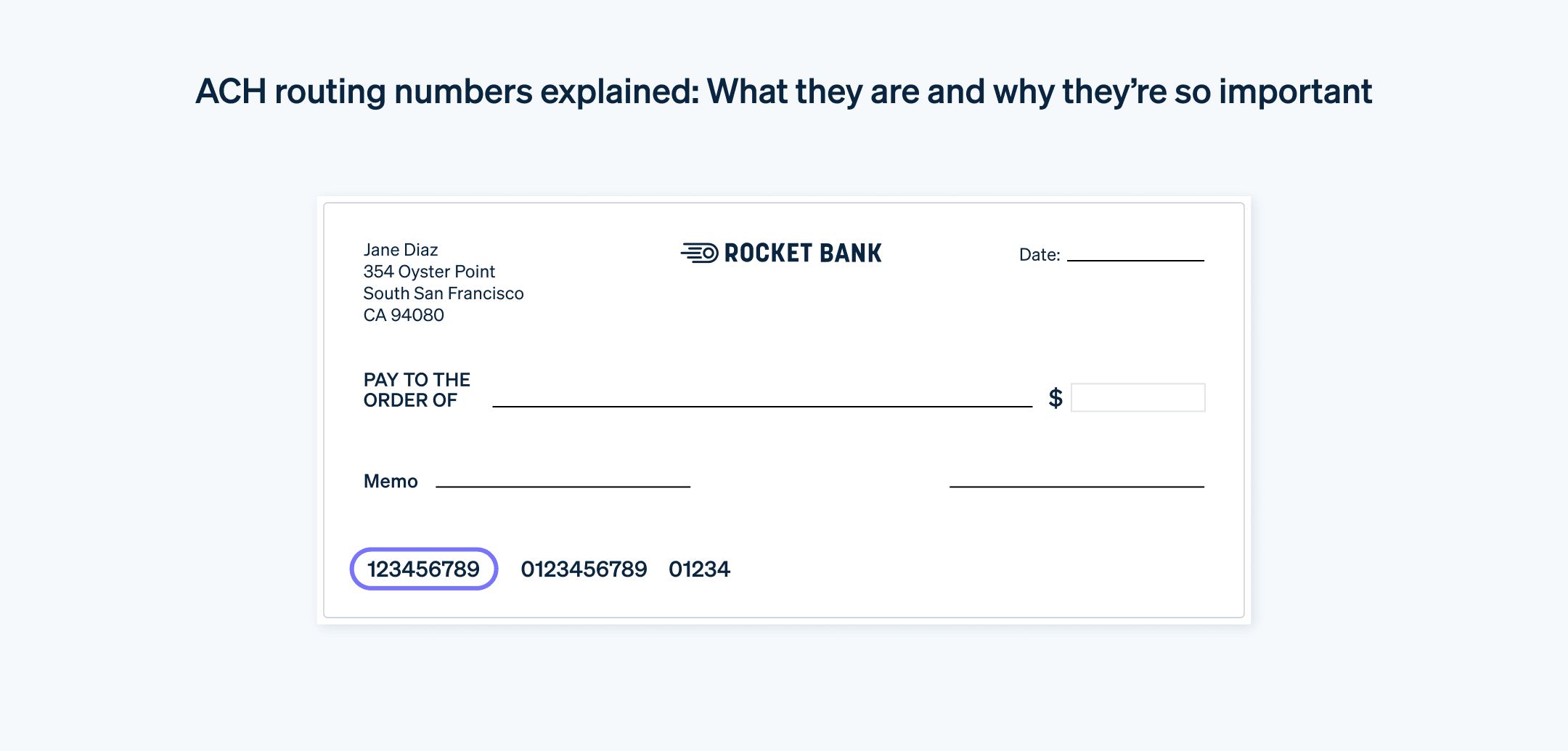ACH 路径号码是一个九位数代码,银行和金融机构用其识别负责美国 境内账户间资金转账的具体机构。如家庭住址,ACH 路径号码将电子转账资金 (EFT) 引向正确的银行和分行。
ACH 路径号码在设置直接存款、自动付款和电汇 时不可或缺。每家银行或信用合作社都有独有的代码。您可通过多种方式找到此代码:查看银行支票底部、在银行网上银行系统查询,或直接联系银行。
商家收发通过 ACH 的付款 需知晓正确的路径号码,确保资金到达正确银行账户。2025 年第一季度,ACH 网络总交易量达 85 亿笔支付,ACH 支付 需求不断增长。以下是您应了解的信息。
本文内容
- 什么是 ACH 号码?
- ACH 路径号码的用途是什么?
- 如何找到 ACH 路径号码?
- ABA 与 ACH 路径号码
- ACH 路径号码的来历
- Stripe 支付能在哪些方面提供帮助
什么是 ACH 号码?
ACH 是 Automated Clearing House(自动清算所)的缩写,是美国境内银行和金融机构之间电子化资金和信息传输的网络。ACH 号码是一种路径号码,专门用于直接存款和账单支付等电子交易。
ACH 路径号码有九位数字,每个数字都有特定的用途。前两位数字表示该机构所在的联邦储备银行区。第二对数字是联邦储备银行分配给该银行的地区分行或处理中心。第五位、第六位、第七位和第八位数字代表该机构在其联邦储备区内的唯一标识符。最后一位数字是校验和,是用于验证前八位数字是否正确的数学总和。
ACH 路径号码的用途是什么?
这些九位数字以多种方式用于将资金引向正确的金融机构。以下是 ACH 路径号码的一些主要用途:
- 雇主使用它们将员工工资直接存入其银行账户。
- 个人和企业使用它们来设置贷款或账单的预定付款。
- ACH 路径号码可促进不同银行账户(个人账户和商家账户均适用)间资金转账。
- 公用事业公司依靠该号码收取客户每月付款。
- 它们用于发送与接收州和联邦税款及退税。
- 企业和非营利组织使用它们来接收所提供服务的捐款或付款。
两种情况下,ACH 路径号码均可确保正确的各方有序而及时地收付款。
如何找到 ACH 路径号码?
有几种方法可查找 ACH 路径号码:
- 检查与该账户关联的支票的底部。传统上,印在左侧的第一组数字是路径号码。
- 查看银行对账单。一些银行在对账单上包含路径号码。
- 登录金融机构的网上银行平台或移动应用程序。通常,路径号码会列在账户信息或账户设置部分。
- 访问银行网站。大多数银行都有一个常见问题解答部分或专门的页面,其中列出了他们的路径号码。
- 致电银行。代表可以在验证账户持有人的身份后提供路径号码。
- 使用美国银行家协会官方路径号码查询工具。任何需要查找或验证路径号码的人都可访问此工具。
ACH 路径号码的示例是 021000322,美国银行(Bank of America)常将其用于自动支付或 ACH 电子交易。
ACH 路径号码可能因地区、账户类型或交易类型而异。有些银行对电汇和 ACH 交易使用不同的路径号码,而另一些银行则对不同地理区域使用多个号码。交易前务必向银行确认正确的路径号码,以避免错误或延误。

ABA 与 ACH 路径号码
尽管 ABA 和 ACH 路径号码均可促成支付处理,但它们用于不同类型交易。
ABA 路径号码(也称路径号码 (RTN))最初设计为推动纸质支票分类、捆扎和发货。如今仍用于实体支票清算和电汇。这些号码位于纸质支票左下角。
ACH 路径号码仅用于电子转账和付款。部分银行 ACH 和 ABA 路径号码相同,但其他一些银行有专门用于 ACH 交易的独立号码。这种区分可帮助机构将交易引向正确处理系统,无论是直接存款、账单付款还是其他自动化转账。使用错误的号码可能导致交易延迟或失败。
以下是 ABA 和 ACH 路径号码间的主要区别:
|
ABA 路径号码 |
ACH 路径号码 |
|
|---|---|---|
|
也称为 |
路径号码 (RTN) |
电子路径号码 |
|
目的 |
用于纸质支票和电汇 |
用于直接存款和账单支付等电子支付 |
|
格式 |
9 位数字 |
9 位数字(通常与 ABA 相同,但也可不同) |
|
查找位置 |
|
|
|
用途 |
银行、信用合作社和联邦储备银行 |
银行和自动清算所网络 |
有些银行对 ABA 和 ACH 使用相同的号码,而另一些银行则根据交易类型分配不同的路径号码。请务必向银行核实,确认您特定用例的正确号码。
ACH 路径号码的来历
ACH 路径号码系统始于 20 世纪,当时银行业开始更有效地以自动化方式处理和整理支票及其他金融交易处理。美国银行家协会 (ABA) 于 1910 年创建 ACH 路径号码系统,以方便纸质支票的分类、捆绑和运输。随着电子交易 日益普及,该系统也随之调整,可用于电子资金处理。
随着电子支付 日益普及,ACH 网络不断扩展。路径号码系统成为处理这些付款 的有效方式,机构无需发送纸质文件即可转账。随着时间推移,ACH 转账 用途不断扩展,涵盖多种支付服务。包括工资直接存款、自动抵押贷款和账单支付,以及政府和商业交易。ACH 网络可处理大量贷记和借记交易,包括直接存款和直接付款。
ACH 路径号码系统的可靠性和有序结构,为电子资金转账的普及以及向无纸化金融系统的转型提供了支持。随着数字交易 量持续增长,路径号码在日常金融操作中仍发挥重要作用。
Stripe 支付能在哪些方面提供帮助
Stripe Payments 提供统一的全球支付解决方案,助力各类商家(从成长型初创企业到全球性企业)接受 ACH Direct Debit 付款。
Stripe 支付可以帮您:
- 优化结账体验: 借助预构建的支付 UI,快速集成 ACH Direct Debit,打造无缝的客户体验,节省数千小时的开发时间。
- 更快拓展美国市场: 触达美国各州的客户;在收取美元付款时,降低多币种管理的复杂性和成本。
- 简化 ACH 授权: 通过 Stripe Checkout、Stripe Payment Element 或 托管发票页面,在支付流程中向客户展示所需的 ACH 授权。
- 提升支付表现: 借助一系列可定制、易于配置的支付工具,增加收入,其中包括一个完全托管的流程,用于收集银行账户详情,并通过 小额存款 进行验证。
- 通过灵活、可靠的增长平台更快地发展: 平台旨在与您一同扩大规模,正常运行时间为 99.999%,具有行业领先的可靠性。
详细了解 Stripe Payments 如何为线上和线下付款提供支持,或立即 开始使用。
本文中的内容仅供一般信息和教育目的,不应被解释为法律或税务建议。Stripe 不保证或担保文章中信息的准确性、完整性、充分性或时效性。您应该寻求在您的司法管辖区获得执业许可的合格律师或会计师的建议,以就您的特定情况提供建议。